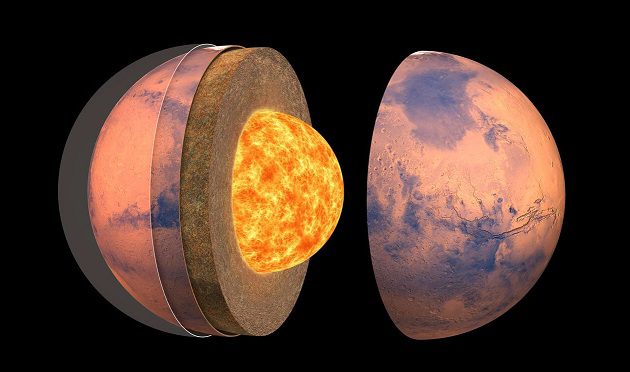Unveiling Mars: A tiny exhibit on the second floor of NASA’s Jet Propulsion Laboratory in Pasadena, California, displays the first television image of Mars. The first space photo of another planet was taken in 1965. The image is a “color by numbers” representation of data, not a photograph.
NASA’s Mariner 4 spacecraft captured and transmitted data from its close encounter with Mars on July 15, 1965. The original photograph was released, but JPL’s exhibit draws visitors with the hand-colored data. This unusual image captivates viewers.
Mariner 4 was crucial. Mariner 2, the first spacecraft to visit Venus in 1962, preceded it. NASA engineers were inspired by this milestone to photograph planets from space. Mariner 4, one of two spacecraft designed to photograph Mars, failed on its first attempt.
Mariner 4 carried many technological advances to Mars. It used S-band frequency for stronger uplinks than previous missions. It also had a television camera and six scientific instruments to study the planet’s surface and atmosphere.
The 1960s space race drove the desire to image other planets. The most detailed Mars map at the time was based on Percival Lowell’s Flagstaff, Arizona, observatory observations from the late 1800s. 1956 Earth-based telescopes captured the highest-resolution image. Thus, Mariner 4 sought unprecedented insights into our neighboring planet.
Mariner 4 took 22 images of Mars from 6,118 miles (9,845.5 kilometers) above on July 14, 1965. Digital imaging was first used outside Earth on this mission. At a painfully slow 8 1/3 bits per second, the camera’s analog signals were converted to digital and transmitted back to Earth. It took 10 hours to send a single image to Earth, unlike today’s high-resolution Mars images.
At JPL, journalists eagerly awaited the first photo. Some Mariner 4 team members created an unexpected art project. The spacecraft’s spare tape recorder converted digital data into ones and zeros on ticker tape. They stapled the strips to a movable wall and colored the numbers by pixel brightness. This unconventional method validated the tape recorder and simulated white-to-black color gradients.
Grumm bought art store pastels with limited funds. The brown, red, and yellow pastels coincided with Mars’ color palette, but the goal was to mimic a gradient from white to black. As the team carefully colored in the numbers, Mars emerged, with dark brown representing space, light colors representing Mars’ surface, and orange representing Martian clouds. Dark camera lens registration marks added authenticity.


READ MORE: Solar Maximum Surges: Sun Activity Peaks Sooner Than Expected
This unique blend of art and science validated the camera and data capture and gave an early glimpse of Mars before the official photograph. The wall-cut tapestry of colored ticker tape was framed and given to JPL Director William Pickering.
Mariner 4 sent all 22 images between July 15 and August 3, 1965. The moon-like terrain Mariner 4 passed over surprised scientists with its craters and clouds. These initial snapshots covered less than 1% of Mars’ surface, but they sparked a thirst for knowledge that drives exploration today.
The Perseverance and Curiosity rovers, the Ingenuity helicopter, and a fleet of orbiters build on Mariner 4. Their research into Mars’ mysteries is illuminating the universe and ourselves. Witnessing and exploring the unknown changes our view of ourselves and the universe.
Mariner 4’s first Mars photo celebrates ingenuity, determination, and artistic creativity. It shows humanity’s insatiable thirst for knowledge and the beauty that can result when science and art collide.
Our Reader’s Queries
What was found on Mars 2023?
The Curiosity rover has discovered fresh evidence of ancient rivers on Mars, a promising indicator for potential past life on the planet. Recent data analysis suggests that many of the craters on Mars may have been former riverbeds, hinting at a potentially habitable environment in the planet’s history.
What makes it difficult to send people to Mars?
Current technology cannot protect astronauts traveling to Mars from the lethal radiation of solar flares and coronal mass ejections (CME), as explained by NASA scientist Dr Michelle Thaller. This radiation would end human lives long before reaching the destination, as normal radiation is present in space.
What is Mars mystery?
A group of scientists have suggested that a vast ocean may have once been present in the lower northern hemisphere of the planet. However, there are skeptics who argue that if we struggle to explain the disappearance of small lakes and rivers on Mars, it seems unlikely that we would be able to understand the drying up of an entire ocean.
Is there a Mars mission in 2026?
The planned launch of MMX for September 2024 would have taken it to Mars by August 2025, and it would have brought back about 0.35 oz (10 grams) of samples from the Mars moon Phobos in 2029. However, the mission is now delayed until the next Mars launch window opens in late 2026. The samples are now expected to reach Earth in 2031.

